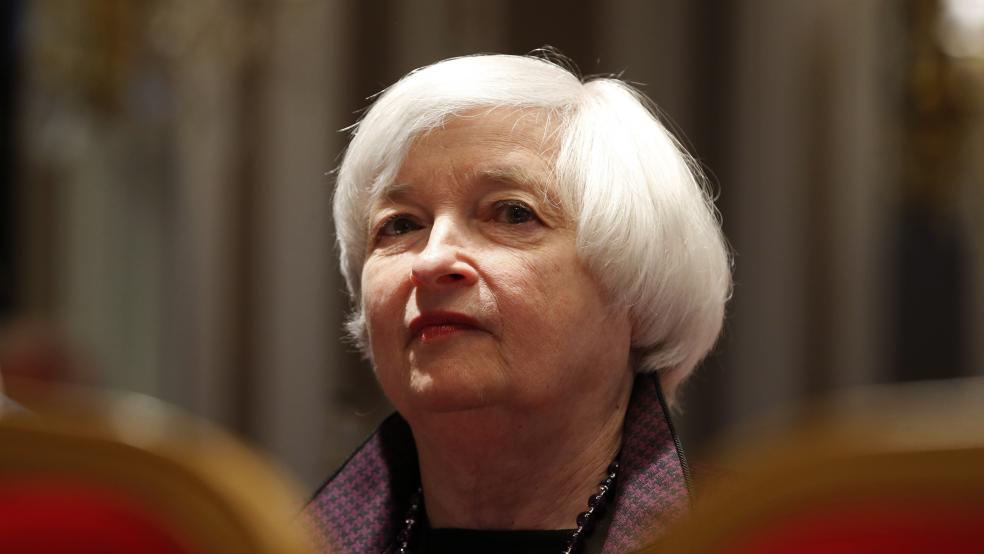It's about to be all about the Federal Reserve.
Last month didn't feature a Federal Open Market Committee meeting, so investors were distracted by things such as the bailout shenanigans in Greece. That's set to change starting on Friday, when the February payroll report provides a final update on the job market ahead of the March 18 Fed policy statement. We'll have another Fed statement on April 29, a break in May, and then the key June 17 decision, when a possible move on interest rates is expected.
For now, Yellen continues to play it cagey and is trying to avoid making any firm commitments for fear of spooking a market that's grown ridiculously dependent on Fed policy moves. I mean, look at the way key words such as "patient" and "considerable time" have been the focus of so much attention in recent months — and how Yellen and other officials have modified their definition of what these words mean about the pace and timing of rate hikes.
Related: Why the ‘Smart Money’ Is Bailing Out of the Bull Market
As the calendar rolls on, the Fed will be forced to make clear, definitive declarations on its intentions.
That'll be a refreshing change from Yellen's ongoing kabuki dance, typified by her recent testimony to Congress, after which market watchers couldn't even agree if she was dovish or hawkish. She indicated that the patience language — which she had previous translated as meaning no rate hikes for two Fed meetings — could be removed soon, possibly at the March meeting, but that it didn't mean a rate hike was necessarily coming within the next two meetings.
Recent chatter reinforces the takeaway that the Fed will soon firm up its guidance on the timing of its first rate hike:
- On Feb. 20, Philly Fed President Charles Plosser noted that the markets seemed to be focusing too much on the Fed policy statement (which was considered dovish) and not paying attention to the very strong spate of job reports.
- On Feb. 23, Richmond Fed President Jeffrey Lacker said the Fed shouldn't worry about upsetting the markets when it feels a policy change needs to happen and warned it may already have waited too long to start raising rates.
- On Feb. 26, Dallas Fed President Richard Fisher said he would rather tighten rates sooner, but at a slower rate, and that markets have overshot and could suffer a correction at some point.
- Also on Feb. 26, San Francisco Fed President John Williams said that a stronger labor market will lead to wage growth and the central bank’s rate liftoff could take place as soon as this summer. And St. Louis Fed President James Bullard said he would rather raise interest rates sooner than react to the data.
- On March 4, Kansas City Fed President Esther George said rate hikes — which she believed should start in the middle of the year — would still leave monetary policy very accommodative and that the economy and job market could be damaged by waiting too long to take action.
Clarity will be provided by the release of the Summary of Economic Projections (SEP) and a post-announcement press conference by Yellen on March 18. The SEP, also known as the "dot plot," was last released in December and will provide — in cold, hard numbers — an updated look at where Fed policymakers believe interest rates, the unemployment rate, inflation and GDP growth are all going.
Hopefully, the press will use the data to push Yellen hard for specifics.
Related: Will Fed Rate Hikes Cost You in Higher Taxes?
Any new information is sure to be reflected in Fed fund futures, which as of right now, are pricing in a single 0.25 percent interest rate hike by the Fed at the September 16-17 policy meeting. Compare that to the 1 percent rise in interest rates Fed policy makers, at the median, expect this year based on the December dot plot data. Either the Fed is overconfident, or the market underestimates the Fed's resolve to raise rates. The Fed or futures traders will need to be proven wrong.
The big reveal will start on Friday, with the jobs report. Societe Generale economist Brian Jones expects that the unemployment rate could drop from 5.7 percent to 5.5 percent — the lowest level since May 2008. That's squarely in the zone economists believe represents the "Non-Accelerating Inflation Rate of Unemployment" or the rate at which the job market is running at full tilt.
Jones expects we'll hit 5.2 percent by this summer as hiring picks up momentum. The Fed estimates NAIRU at somewhere between 5.2 percent and 5.5 percent.
Related: Is the Unemployment Rate of 5.7 Percent Just a ‘Big Lie’?

Any additional declines in the jobless rate represent a pushing past potential — ushering in a rapid rise in wage inflation as businesses start fighting with each other for top talent. Wage gains are a powerful determinant of overall inflation and are thus closely watched, but that kind of bidding war for workers is something we've yet to really see in this economic recovery.
The Fed, despite low inflation, has been sticking to its guns on rate hikes in the anticipation this dynamic will soon come into play. You can already see, in the chart above, how rapidly real wages have been growing over the last nine months as a drop in gas prices has pushed the measure up.
With investors apparently in denial that the Fed is on the verge of starting its first rate tightening campaign since 2004, a strong jobs report and further confirmation on rate hike timing could rattle stocks at a time when sentiment is at a rare height.
Top Reads from The Fiscal Times:
- The 7 Taxes We Hate the Most
- How the Great Beanie Baby Bubble Went Bust
- America Is In Deflation. So What?






